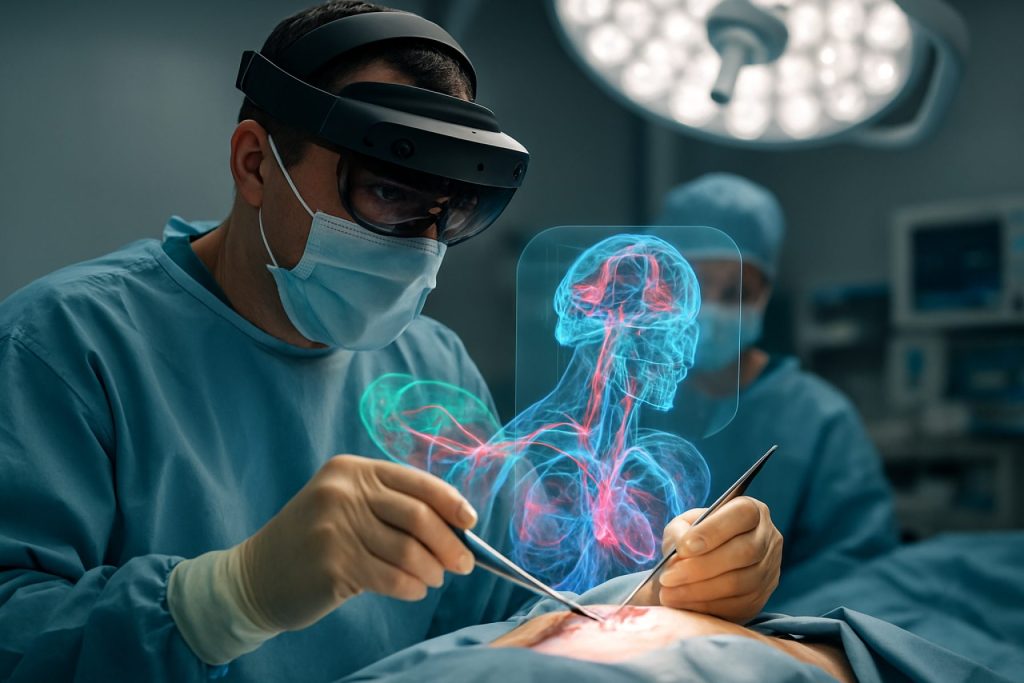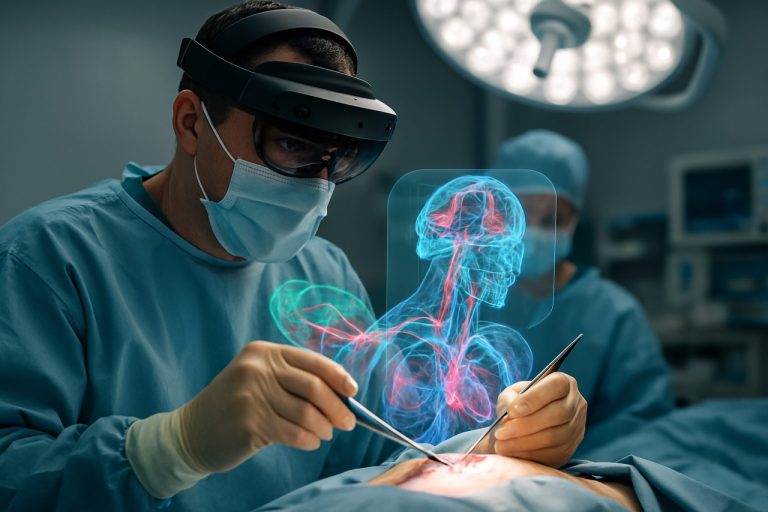
Augmented Reality Guided Surgery Systems Market Report 2025: In-Depth Analysis of Growth Drivers, Technology Innovations, and Global Forecasts. Explore Key Trends, Regional Insights, and Strategic Opportunities Shaping the Future of Surgical Navigation.
- Executive Summary & Market Overview
- Key Technology Trends in AR-Guided Surgery
- Competitive Landscape and Leading Players
- Market Growth Forecasts (2025–2030): CAGR, Revenue, and Volume Analysis
- Regional Market Analysis: North America, Europe, Asia-Pacific, and Rest of World
- Challenges, Risks, and Barriers to Adoption
- Opportunities and Strategic Recommendations
- Future Outlook: Innovations and Market Evolution
- Sources & References
Executive Summary & Market Overview
Augmented Reality (AR) Guided Surgery Systems represent a transformative advancement in the field of surgical navigation and intraoperative visualization. These systems overlay digital information—such as anatomical structures, surgical plans, and real-time imaging—directly onto the surgeon’s view of the operative field, enhancing precision and decision-making. As of 2025, the global market for AR guided surgery systems is experiencing robust growth, driven by technological innovation, increasing adoption in hospitals and surgical centers, and a rising demand for minimally invasive procedures.
According to recent market analyses, the AR guided surgery systems market is projected to reach a valuation of over USD 1.2 billion by 2025, expanding at a compound annual growth rate (CAGR) exceeding 20% from 2020 to 2025. This growth is fueled by the integration of AR with advanced imaging modalities, such as MRI and CT, and the proliferation of high-performance hardware, including head-mounted displays and smart glasses. Key players in this space include Medtronic, Siemens Healthineers, Stryker, and innovative startups like Surgical Theater and Augmedics, all of which are investing heavily in R&D and strategic partnerships to enhance their AR offerings.
Clinically, AR guided surgery systems are being rapidly adopted in neurosurgery, orthopedics, and spinal procedures, where precise navigation is critical. The technology’s ability to reduce operative time, improve surgical accuracy, and minimize complications is increasingly recognized by healthcare providers and payers. Furthermore, regulatory approvals in major markets, such as the U.S. Food and Drug Administration’s clearance of AR navigation platforms, are accelerating commercial deployment and clinician confidence.
Geographically, North America and Europe currently dominate the market, owing to advanced healthcare infrastructure and early technology adoption. However, Asia-Pacific is expected to witness the fastest growth through 2025, supported by expanding healthcare investments and a growing pool of skilled surgeons. Despite high initial costs and integration challenges, the long-term outlook for AR guided surgery systems remains highly positive, with ongoing advancements in artificial intelligence and 5G connectivity poised to further enhance system capabilities and market penetration.
Key Technology Trends in AR-Guided Surgery
Augmented Reality (AR) guided surgery systems are rapidly transforming the landscape of operative medicine by overlaying digital information—such as anatomical structures, surgical plans, and real-time data—directly onto the surgeon’s field of view. In 2025, several key technology trends are shaping the evolution and adoption of these systems, driven by advances in hardware, software, and integration with other digital health technologies.
- Enhanced Visualization and Precision: Next-generation AR headsets and displays, such as those developed by Microsoft and Medtronic, offer higher resolution, wider fields of view, and improved depth perception. These improvements enable surgeons to visualize complex anatomical relationships with unprecedented clarity, supporting more precise navigation and reducing the risk of errors.
- Integration with Artificial Intelligence (AI): AR-guided surgery systems are increasingly leveraging AI algorithms for real-time image analysis, anatomical segmentation, and intraoperative decision support. Companies like Siemens Healthineers are integrating AI-driven insights into AR overlays, allowing for dynamic adaptation to intraoperative changes and personalized surgical guidance.
- Seamless Workflow Integration: Modern AR platforms are designed to integrate seamlessly with hospital information systems, electronic health records, and surgical robots. This interoperability, championed by firms such as Stryker, streamlines preoperative planning, intraoperative navigation, and postoperative assessment, enhancing overall surgical workflow efficiency.
- Remote Collaboration and Telepresence: AR-guided surgery systems now support real-time remote collaboration, enabling expert surgeons to provide guidance or consultation from anywhere in the world. Solutions from Proximie and Augmedics facilitate live annotation, communication, and mentoring, expanding access to specialized expertise and supporting training in complex procedures.
- Regulatory and Clinical Validation: As AR-guided surgery systems mature, regulatory bodies such as the U.S. Food and Drug Administration (FDA) are increasingly providing clear pathways for approval. This trend is accelerating clinical adoption, with a growing body of peer-reviewed studies demonstrating improved outcomes, reduced operative times, and enhanced safety profiles.
These technology trends are expected to drive significant growth in the AR-guided surgery market through 2025 and beyond, as healthcare providers seek to leverage digital innovation for better patient outcomes and operational efficiency.
Competitive Landscape and Leading Players
The competitive landscape for augmented reality (AR) guided surgery systems in 2025 is characterized by rapid technological innovation, strategic partnerships, and increasing market consolidation. The sector is driven by the demand for enhanced surgical precision, reduced operative times, and improved patient outcomes. Key players are leveraging advanced AR visualization, artificial intelligence (AI), and real-time data integration to differentiate their offerings.
Leading the market are established medical technology companies and innovative startups. Medtronic remains a dominant force, building on its Mazor X Stealth Edition platform, which integrates AR and robotics for spine surgery. Smith+Nephew has expanded its AR portfolio through the acquisition of VisionAir Surgical, enhancing its orthopedic navigation systems. Stryker continues to invest in AR-guided solutions, particularly for joint replacement and trauma procedures, leveraging its proprietary visualization technologies.
Among the innovators, Surgical Theater and Augmedics are notable for their specialized AR platforms. Surgical Theater’s Precision VR and Augmedics’ xvision Spine System have gained regulatory approvals and are being adopted in neurosurgery and spinal procedures, respectively. Brainlab is also a significant player, offering AR-enabled navigation for cranial and orthopedic surgeries, and has formed collaborations with hospitals to integrate its technology into clinical workflows.
The competitive environment is further shaped by technology giants entering the healthcare space. Microsoft’s HoloLens 2 is increasingly used as a hardware backbone for AR surgical applications, with software partners developing tailored solutions for intraoperative guidance. Philips and Siemens Healthineers are integrating AR into their imaging and navigation platforms, aiming to provide seamless interoperability across the surgical suite.
- Strategic partnerships between device manufacturers and software developers are accelerating product development and market penetration.
- Regulatory approvals and clinical validation remain key differentiators, with companies investing in multi-center trials to demonstrate efficacy and safety.
- Regional expansion, particularly in North America and Europe, is a focus, but Asia-Pacific is emerging as a high-growth market due to increasing healthcare investments.
Overall, the AR guided surgery systems market in 2025 is marked by intense competition, with leading players prioritizing innovation, clinical evidence, and ecosystem integration to capture market share.
Market Growth Forecasts (2025–2030): CAGR, Revenue, and Volume Analysis
The market for Augmented Reality (AR) Guided Surgery Systems is poised for robust expansion between 2025 and 2030, driven by technological advancements, increasing adoption in healthcare facilities, and growing demand for minimally invasive procedures. According to projections by Fortune Business Insights, the global AR in healthcare market is expected to register a compound annual growth rate (CAGR) of approximately 23% during this period, with AR-guided surgery systems representing a significant and rapidly growing segment.
Revenue forecasts indicate that the AR-guided surgery systems market will surpass USD 2.5 billion by 2030, up from an estimated USD 800 million in 2025. This growth is underpinned by increasing investments from both public and private sectors, as well as the integration of AR with other digital health technologies such as artificial intelligence and robotics. Leading medical device manufacturers, including Medtronic and Smith+Nephew, are expanding their AR product portfolios, further accelerating market penetration.
In terms of volume, the number of AR-guided surgical procedures is projected to grow at a CAGR exceeding 25% from 2025 to 2030. This surge is attributed to the increasing availability of AR platforms in operating rooms, particularly in North America and Europe, where regulatory approvals and reimbursement frameworks are more established. Emerging markets in Asia-Pacific are also expected to witness above-average growth rates, fueled by rising healthcare expenditures and the modernization of surgical infrastructure.
Key drivers for this market growth include:
- Enhanced surgical precision and reduced error rates, leading to improved patient outcomes.
- Growing clinical evidence supporting the efficacy of AR-guided interventions in complex procedures such as neurosurgery, orthopedics, and cardiovascular surgery.
- Strategic collaborations between technology firms and healthcare providers to develop customized AR solutions, as seen in partnerships involving Microsoft HoloLens and leading hospitals.
Overall, the 2025–2030 period is expected to mark a transformative phase for AR-guided surgery systems, with sustained double-digit growth in both revenue and procedure volume, setting the stage for widespread clinical adoption and further innovation in surgical care.
Regional Market Analysis: North America, Europe, Asia-Pacific, and Rest of World
The global market for Augmented Reality (AR) guided surgery systems is experiencing robust growth, with regional dynamics shaped by healthcare infrastructure, regulatory environments, and technological adoption rates. In 2025, North America continues to lead the market, driven by advanced healthcare facilities, significant investments in medical technology, and a high concentration of key industry players. The United States, in particular, benefits from strong R&D funding and early adoption of innovative surgical solutions, with institutions such as the National Institutes of Health supporting clinical research and validation of AR-guided systems. The presence of leading companies like Medtronic and Stryker further accelerates market penetration in the region.
Europe follows closely, with countries such as Germany, the United Kingdom, and France at the forefront of integrating AR into surgical workflows. The region benefits from supportive regulatory frameworks and collaborative initiatives between academic centers and industry. The European Union’s focus on digital health transformation, as outlined by the European Commission, is fostering the adoption of AR-guided surgery systems, particularly in orthopedic and neurosurgical applications. However, market growth is somewhat tempered by variations in healthcare spending and reimbursement policies across member states.
The Asia-Pacific region is emerging as a high-growth market, propelled by expanding healthcare infrastructure, rising investments in medical technology, and increasing awareness of minimally invasive surgical techniques. Countries such as China, Japan, and South Korea are making significant strides, with government initiatives to modernize healthcare and a growing pool of skilled surgeons. Companies like Olympus Corporation and Samsung Medison are actively developing and commercializing AR-guided surgical solutions tailored to regional needs. Despite these advances, challenges such as high initial costs and limited access in rural areas persist.
- North America: Largest market share, rapid adoption, strong R&D ecosystem.
- Europe: Steady growth, regulatory support, but fragmented reimbursement landscape.
- Asia-Pacific: Fastest growth rate, government backing, increasing local innovation.
- Rest of World: Gradual adoption, with Latin America and the Middle East showing interest but facing infrastructural and economic barriers.
Overall, regional disparities in adoption and market maturity are expected to narrow as AR-guided surgery systems demonstrate clear clinical and economic benefits, driving broader global uptake through 2025 and beyond.
Challenges, Risks, and Barriers to Adoption
Despite the promising advancements and growing interest in Augmented Reality (AR) guided surgery systems, several challenges, risks, and barriers continue to impede their widespread adoption as of 2025. These obstacles span technical, regulatory, financial, and human factors, each presenting unique hurdles for stakeholders in the healthcare ecosystem.
- Technical Limitations: AR guided surgery systems require high-precision tracking, real-time data processing, and seamless integration with existing surgical tools and imaging modalities. Current limitations in hardware—such as display resolution, field of view, and latency—can compromise the accuracy and reliability of intraoperative guidance. Additionally, interoperability with hospital IT infrastructure and electronic health records remains a significant challenge, as highlighted by Frost & Sullivan.
- Regulatory and Compliance Hurdles: The regulatory landscape for AR medical devices is complex and evolving. Obtaining approvals from agencies such as the U.S. Food and Drug Administration (FDA) or the European Commission requires rigorous clinical validation, which can be time-consuming and costly. The lack of standardized protocols for AR system validation further complicates the approval process.
- Data Security and Patient Privacy: AR systems often rely on cloud-based data processing and real-time sharing of sensitive patient information. This raises concerns about cybersecurity, data breaches, and compliance with regulations such as HIPAA and GDPR. According to Gartner, healthcare organizations cite data security as a top barrier to adopting advanced digital technologies, including AR.
- Cost and Return on Investment: The high upfront costs of AR hardware, software, and integration, combined with ongoing maintenance and training expenses, can be prohibitive for many healthcare providers. The economic benefits—such as reduced surgical errors or shorter procedure times—are still being quantified, making it difficult for hospitals to justify large-scale investments, as noted by Deloitte.
- Human Factors and Training: Surgeons and operating room staff require specialized training to effectively use AR systems. Resistance to change, concerns about workflow disruption, and the learning curve associated with new technology can slow adoption. A survey by Academy of Medical Royal Colleges found that clinician buy-in is a critical determinant of successful AR implementation.
Addressing these challenges will be essential for AR guided surgery systems to achieve mainstream adoption and deliver on their promise of improved surgical outcomes and patient safety.
Opportunities and Strategic Recommendations
Augmented Reality (AR) guided surgery systems are poised for significant growth in 2025, driven by technological advancements, increasing adoption in minimally invasive procedures, and a growing emphasis on precision medicine. Several key opportunities and strategic recommendations can be identified for stakeholders aiming to capitalize on this evolving market.
Opportunities:
- Integration with Artificial Intelligence (AI): Combining AR with AI-powered analytics can enhance intraoperative decision-making, automate anatomical recognition, and provide real-time feedback, thereby improving surgical outcomes. Companies investing in AI-AR integration are likely to gain a competitive edge.
- Expansion into Emerging Markets: While North America and Europe currently dominate adoption, emerging markets in Asia-Pacific and Latin America present untapped potential due to rising healthcare investments and increasing demand for advanced surgical technologies. Strategic partnerships with local healthcare providers can facilitate market entry.
- Remote Collaboration and Training: AR-guided systems enable remote surgical assistance and training, addressing the shortage of skilled surgeons in underserved regions. Solutions that support tele-mentoring and virtual collaboration are expected to see increased demand, especially in the post-pandemic landscape.
- Customization for Specialty Procedures: Developing AR solutions tailored to specific surgical specialties—such as orthopedics, neurosurgery, and cardiovascular surgery—can address unique clinical needs and drive adoption among specialist surgeons.
- Regulatory Approvals and Reimbursement Pathways: As regulatory bodies such as the U.S. Food and Drug Administration and European Medicines Agency increasingly recognize the clinical value of AR-guided systems, obtaining clearances and establishing reimbursement frameworks will be crucial for market expansion.
Strategic Recommendations:
- Invest in R&D and Clinical Validation: Continuous investment in research and clinical trials will be essential to demonstrate efficacy, safety, and cost-effectiveness, thereby accelerating regulatory approvals and clinician acceptance.
- Forge Strategic Alliances: Collaborations with medical device manufacturers, hospital networks, and academic institutions can accelerate product development and broaden market reach. Notable partnerships, such as those by Medtronic and Siemens Healthineers, exemplify this approach.
- Focus on User Experience and Workflow Integration: Ensuring seamless integration of AR systems into existing surgical workflows and prioritizing intuitive user interfaces will drive adoption among surgeons and operating room staff.
- Monitor Regulatory and Reimbursement Trends: Staying abreast of evolving regulatory requirements and advocating for favorable reimbursement policies will be critical for long-term commercial success.
In summary, the AR-guided surgery systems market in 2025 offers robust opportunities for innovation, expansion, and collaboration. Stakeholders who proactively address clinical, regulatory, and operational challenges will be well-positioned to lead in this transformative sector.
Future Outlook: Innovations and Market Evolution
The future outlook for Augmented Reality (AR) guided surgery systems in 2025 is marked by rapid technological innovation and expanding market adoption. As healthcare providers increasingly seek precision and efficiency, AR-guided systems are poised to transform surgical workflows, offering real-time visualization and enhanced intraoperative guidance. Key industry players are investing heavily in R&D to improve hardware ergonomics, software integration, and data interoperability, which are critical for widespread clinical acceptance.
One of the most significant innovations anticipated in 2025 is the integration of artificial intelligence (AI) with AR platforms. AI-driven analytics will enable more accurate anatomical mapping and predictive modeling, allowing surgeons to anticipate complications and optimize surgical plans. Companies such as Medtronic and Smith+Nephew are already piloting AI-AR hybrid solutions that promise to reduce operative times and improve patient outcomes.
Another trend shaping the market is the miniaturization and wireless connectivity of AR headsets and displays. Next-generation devices are expected to be lighter, more comfortable, and capable of seamless integration with hospital information systems and robotic surgical platforms. This evolution is supported by ongoing collaborations between medical device manufacturers and technology firms, such as the partnership between Microsoft and Philips to leverage the HoloLens platform for surgical navigation.
From a market perspective, the global AR-guided surgery systems market is projected to experience double-digit CAGR through 2025, driven by increasing demand for minimally invasive procedures and the growing prevalence of complex surgeries. According to Fortune Business Insights, the AR in healthcare market is expected to surpass $4 billion by 2025, with surgical applications representing a significant share of this growth.
- Regulatory bodies such as the U.S. Food and Drug Administration (FDA) are streamlining approval pathways for AR-based medical devices, which is expected to accelerate commercialization and adoption.
- Emerging markets in Asia-Pacific and Latin America are anticipated to witness robust adoption, supported by healthcare infrastructure modernization and increased investment in digital health technologies.
In summary, 2025 will likely see AR-guided surgery systems become more intelligent, interoperable, and accessible, fundamentally reshaping surgical practice and patient care worldwide.
Sources & References
- Medtronic
- Siemens Healthineers
- Augmedics
- Microsoft
- Proximie
- Smith+Nephew
- Brainlab
- Philips
- Fortune Business Insights
- National Institutes of Health
- European Commission
- Olympus Corporation
- Samsung Medison
- Frost & Sullivan
- Deloitte
- European Medicines Agency



